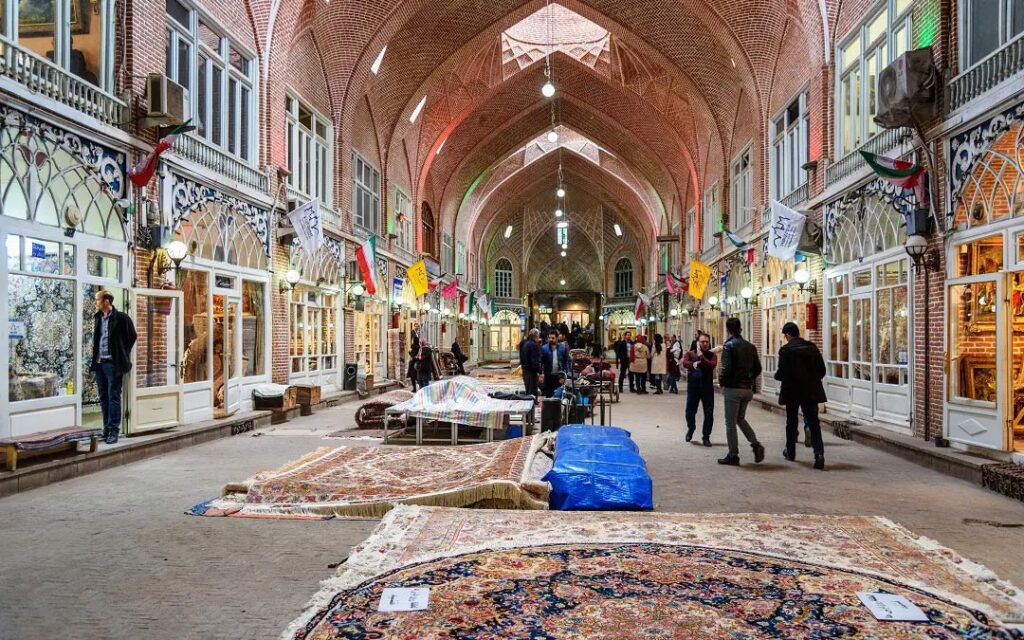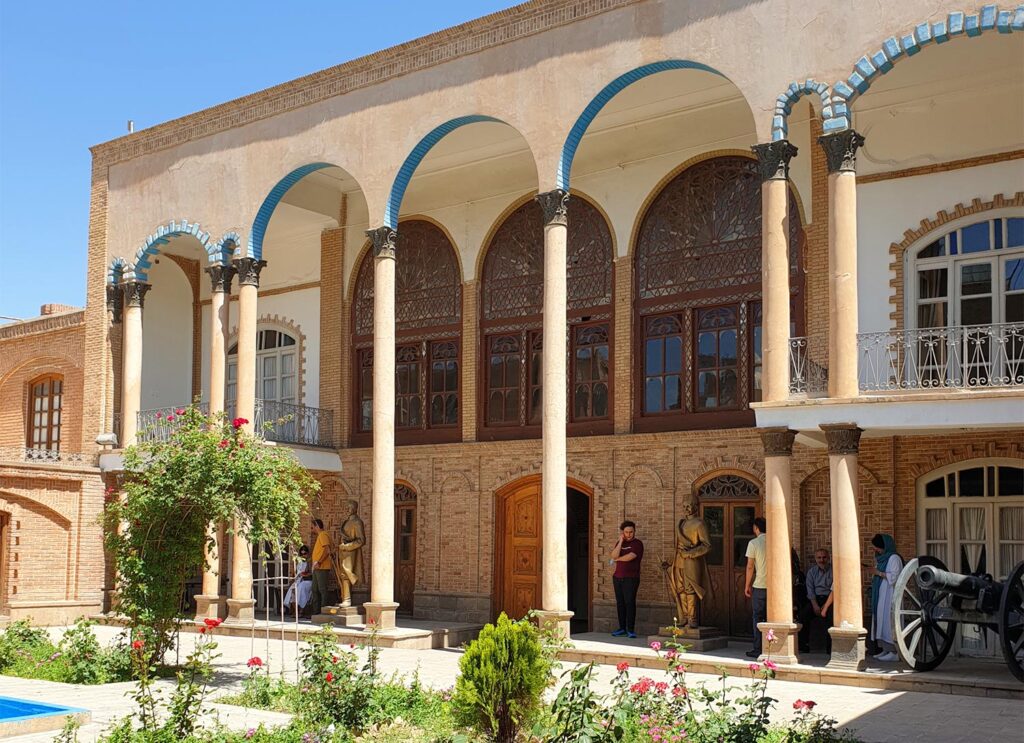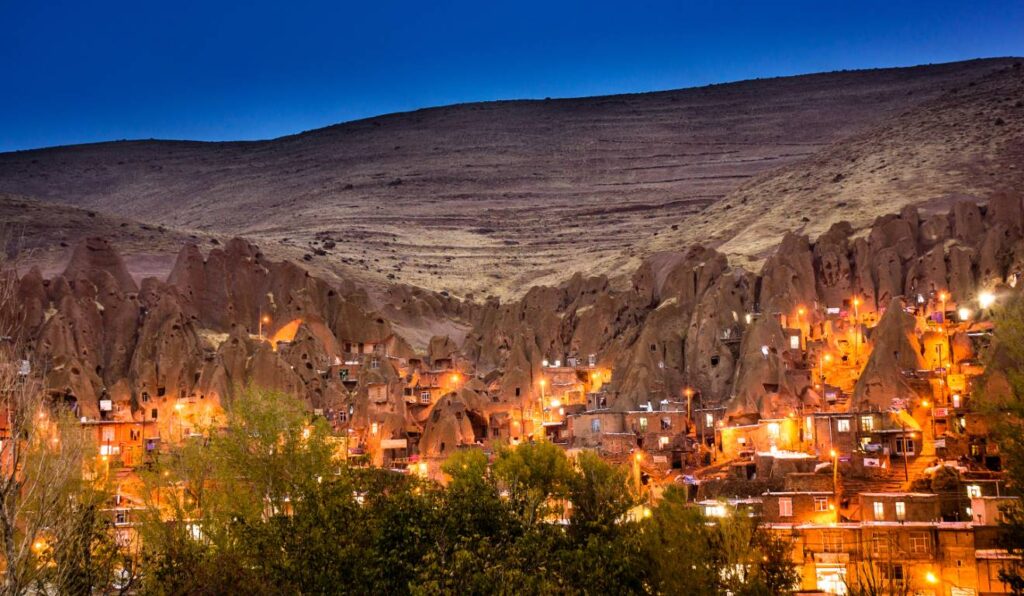Tabriz Historic Bazaar Complex

Tabriz historic bazaar, spanning over one square kilometer, is the world’s largest covered bazaar. The Tabriz Bazaar recognized as a UNESCO World Heritage site, given its historical significance. This market complex contains several caravanserais, mosques, and schools built with brick facades and beautiful domes, captivating the eyes of every visitor.
During the era of the Silk Road, the Tabriz Bazaar held high commercial significance, and its business thrived during the Safavid dynasty. Tabriz market severely damaged in an earthquake in 1779. Still, it rebuilt under the command of the then-governor of Tabriz, Najaf Qoli Khan Donboli. What adds to the charm of this historic market is the ongoing traditional trade and businesses of Tabriz residents, with market activities helping to preserve the authentic art and culture of its inhabitants.
Constitution House of Tabriz
 Constitution House of Tabriz
Constitution House of TabrizSituated in one of the old neighborhoods of the city, Constitution House of Tabriz registered on the list of Iran’s National Monuments in 1975. This mansion belonged to Haj Mehdi Koozehkanani and built in the architectural style of the Qajar era. The Constitution House Museum showcases valuable items, including the waist gun of Sattar Khan, a prominent figure in the Constitutional Revolution, and various historical documents. Every year, many tourists visit the Constitution House Museum of Tabriz to delve into its rich history.
Address of the Constitution House in Tabriz: Tabriz, Shahid Motahari Street, opposite the Jame Mosque.
Discovering Tabriz’s Historical Wonders
Tabriz, the crown jewel of Iran’s historical cities, is home to an array of ancient landmarks that will surely captivate any history aficionado. Here’s a concise guide to some of its most notable historical attractions:
Kabood Mosque
The Kabood Mosque is among the standout attractions of Tabriz. This magnificent edifice commissioned in the 9th century Hijri lunar by Abu Muzaffar Jahan Shah of the Qaraqoyunlu dynasty, upon the insistence of his daughter, Salehe. Like Tabriz’s grand bazaar, the mosque severely damaged during the earthquake in 1193 Hijri lunar. Over the past five decades, parts of it have been restored. Yet, despite its scars, the mosque’s beauty remains untouched. The remaining tiles and calligraphy, handcrafted by ancient artisans, make it an unparalleled architectural marvel. Location: Imam Khomeini Street, Tabriz.
Jameh Mosque
The Jameh Mosque is another historical gem in Tabriz, dating from the Seljuk era to the Qajar period. This mosque is a vivid showcase of the peak of artistry and architecture of the artisans of yesteryears. Its exquisite tile work and intricate floral designs are its hallmark. Like many other historical structures in Tabriz, the Jameh Mosque suffered damage due to earthquakes but has since been refurbished. It was registered as a national Iranian monument in 1310. Location: Shahid Motahhari Street, at the end of Tabriz Bazaar.
Maqbarat-o-Sho’ara (Sorkhab Cemetery)

Tracing its origins to before the 8th century Hijri lunar, this ancient cemetery had been abandoned after sustaining earthquake damage until approximately 1350. An architectural competition was later held for its redesign, which was won by Gholamreza Farzanmehr. Today, its unique design stands as a significant symbol of Tabriz. Over 400 renowned individuals, primarily poets, rest here. Among the most prominent are Hakim Asadi Tusi and Seyyed Mohammad Hossein Behjat Tabrizi, famously known as Shahriar. This cemetery is a must-visit, especially for literature enthusiasts. Location: Sheshgelan District, Soghol-e-Islam Street, intersection of Aref, Tekiyeh Heydar.
Arg-e-Alishah (Tabriz Citadel)

The primary structure of the Arg-e-Alishah dates back to the 8th century AD, during the Ilkhanate era. Originally intended as a mosque, construction halted mid-way after the roof collapsed, leading to the demise of Alishah. During the war between Iran and Russia under the Qajar rule (1804-1824), a military wall erected around the Arg. Registered as a national Iranian monument in 1310, today only the southern wall of the Arg remains. Location: South side of Imam Khomeini and Ferdowsi Street intersection, near Sa’at Square, Tabriz.
Religious Attractions of Tabriz
Venture into the spiritual side of Tabriz as we unveil its religious wonders. Here are some of the most compelling religious sites in this historic city:
Mosque of Sahib al-Amr (Shah Tahmasp Mosque)

Commissioned by Shah Tahmasp, the first of the Safavid dynasty, the Mosque of Sahib al-Amr originally featured one dome and two tall minarets. However, in 1405, it demolished on the orders of Sultan Murad IV of the Ottomans. After the calamity, it reconstructed under Shah Sultan Hussein Safavi, spearheaded by the then minister of Azerbaijan, Mirza Mohammad Ibrahim. This ancient mosque earned its rightful spot on the list of Iran’s national monuments in 1380. Location: Tabriz, end of Darayi Street, Sahib al-Amr Square.
Imamzadeh Seyyed Hamzeh Tabriz

The mausoleum of Imamzadeh Seyyed Hamzeh dates back to the lunar year 714. It initially constructed by his son, Seyyed Hussein, following Seyyed Hamzeh’s demise. The southern part of its courtyard holds the tomb, while the eastern and northern sections serve as educational spaces for religious students. Visitors are captivated by the mirrored artwork and the calligraphy inscribed in Nasta’liq script within the shrine. Location: Tabriz, Sarkhab neighborhood, intersection of Seqat al-Islam Street and Seyyed Hamzeh Bazaar.
Saint Mary Church

Recognized as the largest and oldest church in Tabriz, the Saint Mary Church stands in the Dikbashi area near the Namaz Square (formerly Cyrus the Great Square). Today, it serves as the ceremonial hub for Christian national and religious events. Historically, its primary structure believed to have been established between the years 879 to 979 AD, with architectural cues pointing to the Ilkhanate Mongol era. Post the earthquake in 1158 AD, the church underwent reconstruction, drawing inspiration from Safavid architectural styles. Location: Tabriz, end of Shariati Street (North Shahnaz), corner of Namaz Square.
Natural Attractions of Tabriz
A visit to Tabriz is incomplete without immersing oneself in its natural beauty. Let’s introduce you to some of the breathtaking natural spots the city offers:
Kandovan Village of Tabriz

Situated 50 kilometers from Tabriz is Kandovan, an astonishing attraction with a history spanning over a thousand years. Celebrated for its unique architectural style, the village listed as an Iranian national monument in 1376. Kandovan is one of the world’s three rock villages and the sole rocky region housing nearly 120 families residing in its bee-hive-like rock structures. This village stands out as a living example of rock architecture, teeming with life. Location: East Azerbaijan Province, Osku County.
El Goli (Shah Goli)

Historical Park Shah Goli Park is among Tabriz’s most popular attractions. The El Goli Mansion constructed during the Aq Qoyunlu era and served as the principal water reserve, irrigating gardens in the eastern regions up to Tehran Gate and Topli Bagh. Under the Safavid reign, the park expanded and later handed over to the Tabriz municipality as a public leisure spot during the Pahlavi regime. Interestingly, the word “Gol” in the Turkish language means something akin to “river”. The park boasts a vast lake, 12 meters deep, offering boat rides. In 1378, the majestic garden and mansion of Shah Goli added to the list of national historical monuments. Location: Tabriz, Southern Tabriz Bypass Highway, El Goli Metro Station.
The Museums of Tabriz
Tabriz, often heralded as the city of firsts, is no stranger to the pioneering spirit. Museums in Tabriz follow suit, with many of them established as the foremost in their domains. These repositories not only shelter a treasure trove of precious artifacts but also have intriguing tales to share. For anyone attempting a comprehensive guide to Tabriz, it’s imperative to spotlight the diverse museums of this city and the invaluable pieces they safeguard.
Here, we introduce you to some of the most renowned museums of Tabriz. However, it’s worth noting that the city’s attractions don’t just end with the ones listed below. You can also explore the Natural History Museum of Tabriz, the Master Behzooni Museum, the Master Shahriar Museum, the Stamp Museum, the Armenian Museum, the Tabriz Pottery House, and many more.
Tabriz Sound Museum
The Sound Museum in Tabriz stands out as one of the city’s most captivating destinations. Inaugurated in 2018, it holds the distinction of being the country’s first specialized sound museum. Located within the historic “Amir Parviz’s House” from the Qajar era, the museum in itself is an architectural marvel. Now, imagine this historical edifice combined with displays of musical instruments from Iran and around the world—it’s akin to stepping into a magical realm of melodious music.
This museum segmented into various sections such as a library, restoration workshop, auditory instruments hall, stringed instruments, wind instruments, bowed string instruments, percussion instruments, keyboard instruments, drums and gongs section, bells section, and an audio and photo archive of musicians, musicologists, and singers.
Azerbaijan Museum of Tabriz

The Azerbaijan Museum in Tabriz, following the National Museum of Iran, stands as the country’s second preeminent archaeological museum. It’s undoubtedly one of the quintessential sites to visit in Tabriz. This museum offers a holistic collection that spans artifacts from pre-Islamic times, post-Islamic relics, historical coins and seals, stone carvings, and the sculptural artworks of Tabriz’s artist, Ehad Hosseini. Always welcoming a slew of both domestic and international tourists, this museum is a haven for those eager to delve deeper into ancient times and Iran’s history.
Iron Age Museum, Tabriz
The Iron Age Museum in Tabriz stands out as one of the city’s most exceptional destinations. Holding the title of Iran’s first open-air museum, this place dates back a staggering 3,500 years. What makes it even more intriguing is that it’s a burial site of people who lived during the Iron Age. These graves uncovered in 1997 during an excavation in one of Tabriz’s regions, revealing a deep-rooted history that captivates all who visit. Admittedly, the setting might feel a tad eerie, with its 38 graves. However, their profound archaeological significance has earned them a spot on the country’s national heritage list.
Bazaar and Professions Museum, Tabriz

Among the array of museums in Tabriz, the Bazaar and Professions Museum presents a truly unique experience. As the first specialized bazaar museum, inaugurated in 2017, it showcases all the essential items used by various tradespeople of Tabriz’s market. Here, visitors can closely observe tools and paraphernalia used by professions such as a bazari, telegraph office, exchange shop, pharmacy, and more. The museum beautifully replicates the ambiance of an old bazaar with its 12 diverse stalls, inviting you on a journey through the winding alleys of Tabriz’s ancient market.
City Hall Museum, Tabriz

The City Hall Museum in Tabriz claims the distinction of being the country’s first municipality building to be established in a historic edifice. It’s undeniably one of Tabriz’s must-visit attractions, housing a plethora of invaluable artifacts. The museum consists of various sections including galleries for vintage cameras, Sacred Defense, carpets, Tabriz shoes, sound, wisdom, printing technology, municipal documents, calligraphy, and contemporary arts.
Cartoon Museum, Tabriz
The Cartoon Museum, also known as the Caricature Museum of Tabriz, holds the honor of being the fifth cartoon museum globally and the only one in Iran. Proudly showcasing the world’s most extensive archive of original cartoon artworks, it offers a stunning collection from the globe’s top cartoonists. Within its walls, you’ll find cartoon sculptures, galleries displaying global cartoon artworks, a permanent exhibition of artists’ creations, a complete archive, a library, and the Eastern Azerbaijan cartoonists’ association office.
Historic Houses of Tabriz
Historic houses are profoundly different from ordinary ones. Over time, hundreds of people with diverse stories have inhabited these houses. Observing remnants of their lives is like taking a breath in the past – it’s captivating and thrilling. Tabriz ranks second when it comes to the abundance of historic houses. By saying “second,” we mean that over 600 historic homes have been identified in Tabriz, and discoveries continue. In this section of our comprehensive guide to Tabriz, we’ll introduce you to a few notable historic houses and attractions.
House of Shahriar

The house of Shahriar is among the prominent historic sites in Tabriz. This was the residence of Shahriar, the acclaimed poet known for “Heydar Babaya Salam,” a masterpiece in Azerbaijani Turkish literature. The Tabriz municipality purchased the house in 1987, and all of Shahriar’s belongings, manuscripts, books, and memorabilia are now on display for the public. For those keen on gaining a deeper understanding of this significant poet, visiting the House of Master Shahriar is a golden opportunity.
House of Parvin E’tesami

Parvin E’tesami, a celebrated contemporary poet, was born in Tabriz. The two-story building where she lived until the age of seven has been preserved and stands as one of Tabriz’s historic houses open to all. Constructed in the early Pahlavi era, its unique architecture is registered as a national monument of Iran.
Laleh House

The Laleh House in Tabriz dates back to the Pahlavi period and belonged to one of the founders of museums in Iran. This beautiful two-story historic structure boasts exquisite plasterwork. The courtyard is adorned with tulip designs, making the Laleh House a picturesque site in Tabriz. The vibrant red and yellow colors of the tulips, set against the backdrop of history, is truly enchanting.
Hariri House in Tabriz

The Hariri House can be described as the most beautiful historic house in Tabriz. Hailing from the Qajar period, it comprises an inner courtyard, an outer courtyard, and two house blocks. The entire house is adorned with wall paintings typical of the Qajar era. When visiting the Hariri House in Tabriz, the colorful frescoes narrate historical tales, offering an experience that might be unparalleled for many.
Behnam House in Tabriz

Among the oldest historic houses in Tabriz, the Behnam House has an intriguing tale to tell. Its construction dates back to the late Zand dynasty, encapsulating beautiful architectural features. This historic building underwent renovation during the reign of Naser al-Din Shah in the Qajar architectural style. In 1997, it was added to Iran’s national heritage list.